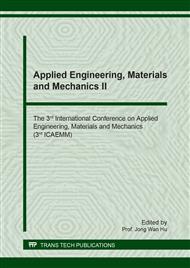p.56
p.62
p.67
p.72
p.77
p.82
p.88
p.94
p.100
Graphene/Thermoplastic Polyurethane Composites
Abstract:
Thermoplastic polyurethane/graphene nanocomposites were successfully prepared by mixing masterbatches with neat polymers using the melt compounding process. Graphene was obtained from graphite by the chemical mean. Graphite was initially converted into graphite oxide which was then converted to graphene oxide. Graphene oxide was then reduced by L-ascorbic acid to obtain graphene. The effects of graphene addition on thermal and morphological properties of nanocomposite were studied by a differential scanning calorimeter, a thermal gravimetric analyzer and a scanning electron microscope. TPU/graphene nanocomposites showed higher melting temperature compared to TPU. On the other hand, heat of fusion of nanocomposites was lowered. TPU and TPU/graphene nanocomposites have two steps of decomposition. The first degradation of TPU occurred at higher temperature compared with nanocomposites but the second degradation showed the opposite results. The percentage of residue after thermal degradation of nanocomposites was lower than that of TPU. For surface morphology, nanocomposite exhibited the rougher surface comparing with TPU and well graphene dispersion in TPU phase was achieved. Nevertheless, there were some agglomeration of graphene.
Info:
Periodical:
Pages:
77-81
Citation:
Online since:
July 2018
Authors:
Price:
Сopyright:
© 2018 Trans Tech Publications Ltd. All Rights Reserved
Share:
Citation:


